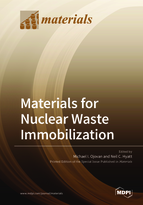Materials for Nuclear Waste Immobilization
A special issue of Materials (ISSN 1996-1944).
Deadline for manuscript submissions: closed (1 June 2019) | Viewed by 46687
Special Issue Editors
Interests: structure and properties of amorphous materials including the viscosity and glass transition; materials for nuclear waste immobilization; waste processing technologies
Special Issues, Collections and Topics in MDPI journals
Interests: radioactive waste management and disposal; advanced nuclear materials; structure–property relations in mixed metal oxides
Special Issue Information
Dear Colleagues,
Nuclear energy is clean, reliable and competitive with many useful applications among which power generation is the most important, where it can gradually replace fossil fuels and avoid massive pollution to the environment. A useless by-product, resulting from utilization of nuclear energy in both power generation and other applications, such as in medicine, industry, agriculture, and research, is nuclear waste.
Safe and effective management of nuclear waste is crucial in ensuring sustainable utilization of nuclear energy. Nuclear waste must be processed to make it safe, which includes its conditioning, so it is immobilized and packaged before storage and disposal. Immobilization of waste radionuclides in durable wasteform materials provides the most important barrier to contribute to the overall performance of any storage and/or disposal system. Materials for nuclear waste immobilization are, thus, at the core of multibarrier systems of isolation of radioactive waste from environment aimed to ensure long term safety of storage and disposal.
This Special Issue aims to analyze the materials currently used, as well as novel materials for nuclear waste immobilization, including technological approaches utilized in nuclear waste conditioning pursuing to ensure efficiency and long-term safety of storage and disposal systems. It will focus on cementitious materials, geopolymers, glasses, glass composite materials, and ceramics developed and used in nuclear waste immobilization with performance of such materials of the utmost importance.
Dr. Michael I OjovanProf. Neil C. Hyatt
Guest Editors
Manuscript Submission Information
Manuscripts should be submitted online at www.mdpi.com by registering and logging in to this website. Once you are registered, click here to go to the submission form. Manuscripts can be submitted until the deadline. All submissions that pass pre-check are peer-reviewed. Accepted papers will be published continuously in the journal (as soon as accepted) and will be listed together on the special issue website. Research articles, review articles as well as short communications are invited. For planned papers, a title and short abstract (about 100 words) can be sent to the Editorial Office for announcement on this website.
Submitted manuscripts should not have been published previously, nor be under consideration for publication elsewhere (except conference proceedings papers). All manuscripts are thoroughly refereed through a single-blind peer-review process. A guide for authors and other relevant information for submission of manuscripts is available on the Instructions for Authors page. Materials is an international peer-reviewed open access semimonthly journal published by MDPI.
Please visit the Instructions for Authors page before submitting a manuscript. The Article Processing Charge (APC) for publication in this open access journal is 2600 CHF (Swiss Francs). Submitted papers should be well formatted and use good English. Authors may use MDPI's English editing service prior to publication or during author revisions.
Keywords
- Radioactive waste
- Nuclear waste management
- Nuclear waste immobilization
- Nuclear wasteforms
- Plasma treatment for nuclear waste immobilization
- Vitrification technologies for nuclear waste immobilization
- Materials for nuclear waste immobilization
- Cementitious materials for nuclear waste immobilization
- Geopolymers for nuclear waste immobilization
- Polymeric materials for nuclear waste immobilization
- Bitumens and bituminization for nuclear waste immobilization
- Glasses for nuclear waste immobilization
- Glass composite materials for nuclear waste immobilization
- Ceramics for nuclear waste immobilization
- Metals for nuclear waste conditioning.








